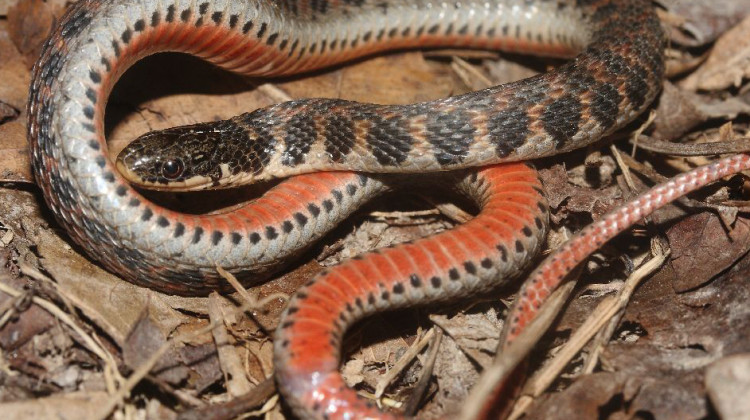
A Kirtland's snake found in Clay County, 2015. The snake is being considered for a federal endangered species listing.
Andrew Hoffman / FlickrThe state-endangered Kirtland’s snake has been found in some unlikely places. Herpetologists in a panel discussion said that’s a good sign for its recovery.
It’s a small snake with a bright red belly that primarily lives in wet meadows and prairies.
The Sycamore Land Trust is partnering with the Indiana Department of Natural Resources to restore a wetland north of Bloomington. While doing an initial species survey there, they found Kirtland’s snakes in a recently abandoned soybean field near its habitat.
DNR State Herpetologist Nate Engbrecht said because the farm used no-till agriculture, the snakes were able to live in crayfish burrows there.
“The burrows are intact compared to traditional tilling techniques where it would actually crush the burrows and the crayfish would have to build new ones,” he said.
Engbrecht said they also found the snakes in wetlands that had been restored sometime between seven to 15 years ago. Even under ideal conditions, experts say it can take anywhere from 20 to 100 years for a restored wetland to function well.
“Holy cow, these things are starting to like use these wetlands almost immediately after they're built. And that's a really good sign when we start thinking about Kirtland’s snake management and recovery,” Engbrecht said.
The snake is also being considered for a federal endangered species listing. Environmental advocates say federal protections could help preserve Indiana wetlands.
READ MORE: Federal protections for a rare snake could help preserve some Indiana wetlands
Join the conversation and sign up for the Indiana Two-Way. Text "Indiana" to 765-275-1120. Your comments and questions in response to our weekly text help us find the answers you need on climate solutions and climate change at ipbs.org/climatequestions.
Engbrecht said there's still a lot experts don't know about the Kirtland's snake — it's natural history, biology, population size, and movement patterns. The DNR aims to answer some of these questions by tracking individual snakes — using the pattern on the snakes' faces to identify who's who.
Rebecca is our energy and environment reporter. Contact her at rthiele@iu.edu or follow her on Twitter at @beckythiele.
 DONATE
DONATE






 Support WFYI. We can't do it without you.
Support WFYI. We can't do it without you.